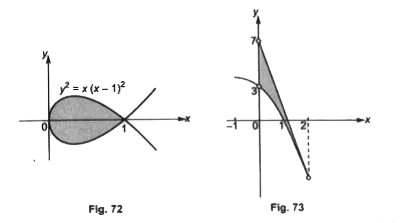Find the area of the loop of the curve y2=x(1−x)2.
The correct Answer is:815 sq units
To find the area of the loop of the curve given by the equation y2=x(1−x)2, we will follow these steps:
Step 1: Understand the Curve
The equation y2=x(1−x)2 describes a curve that has a loop. To find the area of the loop, we first need to identify the points where the loop intersects the x-axis.
Step 2: Find Intersection Points
Set y=0:
0=x(1−x)2
This gives us:
x=0or(1−x)2=0⇒x=1
Thus, the curve intersects the x-axis at x=0 and x=1.
Step 3: Determine the Area of the Loop
The area enclosed by the loop can be calculated using the definite integral of the upper half of the curve from x=0 to x=1. The upper half of the curve is given by:
y=√x(1−x)2=(1−x)√x
The area A can be expressed as:
A=2∫10(1−x)√xdx
We multiply by 2 because the area below the x-axis (the lower half) is symmetric to the area above the x-axis.
Step 4: Solve the Integral
Now we will compute the integral:
A=2∫10(1−x)√xdx
Expanding the integrand:
A=2∫10(√x−x√x)dx=2(∫10x1/2dx−∫10x3/2dx)
Step 5: Evaluate the Integrals
1. For the first integral:
∫10x1/2dx=(x3/23/2)10=23
2. For the second integral:
∫10x3/2dx=(x5/25/2)10=25
Step 6: Combine the Results
Now substitute back into the area formula:
A=2(23−25)
Finding a common denominator (15):
A=2(1015−615)=2(415)=815
Final Answer
Thus, the area of the loop of the curve y2=x(1−x)2 is:
815
The equation y2=x(1−x)2 describes a curve that has a loop. To find the area of the loop, we first need to identify the points where the loop intersects the x-axis.
Set y=0:
0=x(1−x)2
This gives us:
x=0or(1−x)2=0⇒x=1
Thus, the curve intersects the x-axis at x=0 and x=1.
The area enclosed by the loop can be calculated using the definite integral of the upper half of the curve from x=0 to x=1. The upper half of the curve is given by:
y=√x(1−x)2=(1−x)√x
The area A can be expressed as:
A=2∫10(1−x)√xdx
We multiply by 2 because the area below the x-axis (the lower half) is symmetric to the area above the x-axis.
Now we will compute the integral:
A=2∫10(1−x)√xdx
Expanding the integrand:
A=2∫10(√x−x√x)dx=2(∫10x1/2dx−∫10x3/2dx)
1. For the first integral:
∫10x1/2dx=(x3/23/2)10=23
2. For the second integral:
∫10x3/2dx=(x5/25/2)10=25
Now substitute back into the area formula:
A=2(23−25)
Finding a common denominator (15):
A=2(1015−615)=2(415)=815
Thus, the area of the loop of the curve y2=x(1−x)2 is:
815
Topper's Solved these Questions
- APPLICATIONS OF DEFINITE INTEGRALS ( AREA ) BOOK - NAVNEET PUBLICATION - MAHARASHTRA BOARDCHAPTER - APPLICATIONS OF DEFINITE INTEGRALS ( AREA ) EXERCISE - EXAMPLES FOR PRACTICE (2 MARKS )
8 Videos
- APPLICATIONS OF DERIVATIVES BOOK - NAVNEET PUBLICATION - MAHARASHTRA BOARDCHAPTER - APPLICATIONS OF DERIVATIVES EXERCISE - MULTIPLE CHOICE QUESTIONS
12 Videos
Similar Questions
Knowledge Check
The area bounded by the loop of the curve y2=x2(1−x) is
A25sq.unitsB85sq.unitsC215sq.unitsD815sq.unitsThe area of the loop between the curve y=asinx and x-axis is (A) a (B) 2a (C) 3a (D) none of these
AaB2aC3aDNoneArea bounded by the loop of the curve
ay2=x2(a−x) is equal toA415a2B815a2C1615a2DNone
Compute the area enclosed by the loop of the curve y2=x(x−1)2
View SolutionFind the area enclosed betweent the curve y=x2+3,y=0,x=−1,x=2.
View SolutionFind the area of the bounded by the curve y2=2x+1 and the line x-y=1
View SolutionFind the area enclosed by the curves y=4x2 and y2=2x.
View SolutionFind the area of the region bounded by the curves y2=x+1 and y2=−x+1.
View Solution

